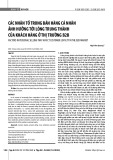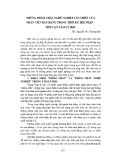
Chapter 3 Filling Vacant Positions
Appendix 3c - What Every Supervisor Should Know About Position Descriptions
1
What is a Position Description?
State statutes define a position as a "group of duties and responsibilities...which require the
services of an employee on a part-time or full-time basis." A position description (PD) is a
structured document assigning work to a given position as it is expected to be performed after
customary orientation and training. It will tell the reader what the worker is responsible for
doing, how it is done, and how it relates to other positions within and outside the work unit.
The PD should accurately and completely describe the permanent duties and responsibilities
that are assigned and performed. Position descriptions are not intended to cover every kind of
work assignment a position may have. Rather, they cover those work assignments which are
predominant, permanent and recurring.
Who Writes the Position Description?
By state statute, the agency appointing authority assigns work to employees. S/he may
delegate this responsibility to subordinate staff. This means that the PD can be written by the
supervisor, employee, manager or personnel officer. Since the first-line supervisor is almost
always responsible for directly assigning and reviewing the work (on behalf of the appointing
authority), the PD is most often written or reviewed by him/her. employees can and often do
have important ideas and information which can be used for updating the PD. However, it is not
an official assignment without the supervisor's approval.
Why are Position Descriptions Important?
Position descriptions are necessary documents which affect employees' positions in a multitude
of areas, including: assignment of duties, classification of the position, identification of training
and development needs, recruitment and exam development, organization and planning of the
work unit, and the establishment of performance evaluation goals and standards.
Position descriptions are particularly important when a personnel management survey is being
conducted of the occupational area. It is crucial that supervisors ensure the position
descriptions of their staff are accurate and comprehensive descriptions of the assigned duties.
During a survey, PDs are a vital source document used in the classification analysis of the
assigned duties; comparisons to the external private and public sector labor market; internal
comparisons to similar positions in state service; the comparison of the position to the new
classification specifications; and reallocation to the appropriate new classification and level.
What Does the Employee's Signature on a Position Description Mean?
Look at section 17 on the position description form. The statement preceding the line for the
employee's signature says, "I have read and understand that the statements and time
estimates above and on attachments are a description of the functions assigned my position."
The employee's signature does not mean the employee agrees with or likes the PD
and its assigned duties. Signing the PD means the employee understands the work
assignments. It is not necessary that the employee agrees with the assignments. If the
employee refuses to sign, the supervisor should attach a note to the PD stating that the duties
have been explained to the employee and the employee refuses to sign. A copy of the PD and
note should be provided to the agency personnel office. employees can be held accountable for
work assignments on a PD they refuse to sign as long as the assignments are reasonable and
within the employee's control.

Chapter 3 Filling Vacant Positions
Appendix 3c - What Every Supervisor Should Know About Position Descriptions
2
Does an employee have to Perform Any Duties Not Identified on Their Position
Description?
A position description cannot and does not list every task an employee must perform as part of
their job. Tasks which are understood as necessary to accomplish the goals listed on a PD are
required to be performed. In addition, tasks which are reasonably related but not on the PD can
also be assigned. Finally, employees may periodically receive work assignments of a temporary
nature which are not on or related to tasks on their PD. This is also acceptable as long as other
contractual and legal requirements are met. For example, there are limitations on the
assignment of "bargaining unit" work which might violate contractual overtime requirements.
Does the Use of "Buzz Words" Increase the Likelihood of a Position Being Reclassified or
Reallocated to a Higher Level?
"Buzz words" do not increase the likelihood of a reclassification or reallocation being approved.
What is key is the assignment and performance of work consistent with the classification
and level being requested. If the classification specification contains key words and concepts,
then a position which performed those duties is more likely to be reclassified or reallocated to
that level. However, just writing the "buzz words" in a PD is insufficient. During the review
process, the Personnel Office will be verifying that the work listed on the PD is being performed.
Position Description Guidelines
University of Wisconsin-Madison Classified Personnel
A position description form is really nothing more than a clear, concise and complete outline of
the position. To be clear, the information must be in a language the average reader can
understand. To be concise, unnecessary wording and unnecessary details should be omitted. To
be complete, all information that will help the reader understand the position must be included.
Purpose of Position Description
The position description is the key document used in determining the appropriate classification
and level of a position. It is descriptive of the major goals of the position, but it is not construed
to limit or modify the power of the appointing authority to assign work to employees. It should
be used as an information source for the development and implementation of an effective
recruitment and selection plan if a position becomes vacant. An accurate position description
helps the employee know what is expected by clearly defining the work to be performed in
relation to the overall goals of the work unit. The position description can be the basis for
identifying training needs and criteria for evaluating performance.
Completing the Position Description
The position description should be filled out by the first-line supervisor or his/her designee.
Most of the items on the position description are self explanatory. Should you have any
questions, please contact your employing unit Personnel Representative.
Whenever a position description accompanies a personnel transaction, a current organization
chart of the work unit should be included. The organization chart should show the employees'
names, superordinate-subordinate relationships, classifications and current work schedules.

Chapter 3 Filling Vacant Positions
Appendix 3c - What Every Supervisor Should Know About Position Descriptions
3
Definitions
• Goals: the expected results of each employee's work; the expected accomplishments,
product or output that results from the work activities of the employee.
• Worker Activities: the specific tasks the employee performs to accomplish the goal.
Worker Activity statements describe what a worker actually does.
• % Time: the proportion of the employees's total work time in the course of a year spent
on a goal or worker activity.
• Close Supervision: the work is performed according to detailed instructions and
supervision is available on short notice.
• Limited Supervision: the incumbent proceeds on his/her own initiative while complying
with policies, practices and procedures prescribed by the supervisor. The supervisor
generally answers questions only on the more important phases of the work.
• General Supervision: the work is performed independently. The incumbent seldom
refers matters to supervisor except for clarification of policy.
The Form
POSITION DESCRIPTION
DER-PERS-10 (Rev. 5/84)
State of Wisconsin
Department of Employment Relations
DIVISION OF PERSONNEL
IMPORTANT: PLEASE READ INSTRUCTIONS ON BACK OF LAST SHEET OF POSITION DESCRIPTION
FORM. THIS IS VALUABLE INFORMATION.
1. POSITION NUMBER Internal employing unit numbering system. This is a way for the
employing unit personnel representative to identify it's reclassification requests.
2. CERTIFICATION/RECLASSIFICATION REQUEST NUMBER For reclassification:
leave blank. Classified Human Resources will enter an assigned number, followed by the
assigned Personnel Specialist's initials for that reclassification. For certification
request: enter the certification request number appearing in the upper right-hand
corner.
3. AGENCY NUMBER The UW-Madison's number is 285 for all transactions.
4. NAME OF employee: For Certification Request actions: leave blank. For
Reclassification actions: enter the last name first, then the first name and the middle
initial.
5. DEPARTMENT, UNIT, WORK ADDRESS The first line should be "University of
Wisconsin - Madison". The second line should be the college or division and department.
6. CLASSIFICATION TITLE OF POSITION: For classification request action: the
classification title should be identical to item 17 (Note: this is the "Requested Class on
the Certification Request Form"). For Reclassification actions: it should be the
position's present classification title.
7. CLASS TITLE OPTION (TO BE FILLED IN BY ): This is a generic title used to more
specifically identify a position for recruitment, examination and certification or layoff
when job analysis has shown that the special characters and qualifications of the
position so necessitate.
8. NAME AND CLASS OF FORMER INCUMBENT Name and class of the last incumbent to
fill the position. T

Chapter 3 Filling Vacant Positions
Appendix 3c - What Every Supervisor Should Know About Position Descriptions
4
9. AGENCY/WORKING TITLE OPTION Working title of position, if different from
classification title of position. This is the working title within the organization and does
not have to be an official Civil Service Title.
10. NAME AND CLASS OF EMPLOYEES PERFORMING SIMILAR DUTIES If there are
other jobs within the department or if you know of other jobs outside of the department
that are similar, enter the incumbent's name and classification. Otherwise enter "None in
department."
11. NAME AND CLASS OF THE FIRST-LINE SUPERVISOR Self explanatory.
12. FROM APPROXIMATELY WHAT DATE HAS THE employee PERFORMED THE WORK
DESCRIBED BELOW? For Certification Request action: this can be left blank. For
Reclassification action: the incumbent must have performed the permanently
assigned duties at least 6 months, preferably longer.
13. DOES THIS POSITION SUPERVISE SUBORDINATE employeeS IN PERMANENT
POSITION? If YES, complete a Supervisory Position Analysis form (DER-PERS - 84)
14. POSITION SUMMARY - PLEASE DESCRIBE BELOW THE MAJOR GOALS OF THIS
POSITION The summary statement gives an overview of the position. It should
summarize the goals of the position and describe the essential purpose of the job. The
summary statement should indicate the degree of supervision, discretion and the level of
responsibility or authority; describe the context in which the work is performed;
organizational relationship and the physical location of the position. Perhaps it would be
well to wait until Item 15 (describe the goals and work activities of this position) has
been completed before writing the summary. If the Goals and Worker Activities are
clear, concise and complete, then Item 14 can be merely a restatement of the Goals.
The position summary should give the reader a quick overview of the duties and the
level of responsibility of the position.
15. DESCRIBE THE GOALS AND WORKER ACTIVITIES OF THIS POSITION
a. GOALS: Describe the major achievements, outputs or results. List them in
descending order of importance.
b. WORKER ACTIVITIES: Under each goal, list the worker activities performed to
meet that goal.
c. TIME %: Include for each goal. If any major worker activity accounts for more
than 10% of the whole job, the % should be specified.
16. SUPERVISORY SECTION - TO BE COMPLETED BY THE FIRST-LINE SUPERVISOR
OF THIS POSITION See instructions on the back of the last page of the position
description form. The supervisor's signature indicates that the above description is what
the department wants the job to accomplish and how it wants it accomplished.
17. employee SECTION - TO BE COMPLETED BY THE INCUMBENT OF THIS
POSITION If the employee is just starting on the job, his/her signature indicates an
understanding that the above description is what the job is to be. If the employee has
been on the job for some time, his/her signature indicates that the above description is
an outline of what the job consists of.
18. SIGNATURE OF PERSONNEL MANAGER/PERSONNEL REPRESENTATIVE The
signature and date are a required part of the position description.

![Cẩm nang Bán hàng online từ A-Z hiệu quả cho người mới bắt đầu [Chuẩn Nhất]](https://cdn.tailieu.vn/images/document/thumbnail/2025/20251018/kimphuong1001/135x160/7751760756882.jpg)
![Tài liệu học tập Thực tập Quản trị bán hàng [mới nhất]](https://cdn.tailieu.vn/images/document/thumbnail/2025/20250910/kimphuong1001/135x160/26761757561364.jpg)
![Tài liệu học tập Giao dịch và đàm phán kinh doanh [Mới nhất]](https://cdn.tailieu.vn/images/document/thumbnail/2025/20250716/vijiraiya/135x160/679_tai-lieu-hoc-tap-giao-dich-va-dam-phan-kinh-doanh.jpg)




![Tài liệu học tập Giao dịch và đàm phán kinh doanh Phần 2: [Thêm thông tin chi tiết nếu có]](https://cdn.tailieu.vn/images/document/thumbnail/2021/20210705/lovebychance06/135x160/858737466.jpg)
![Tài liệu học tập Giao dịch và đàm phán kinh doanh Phần 1: [Mô tả thêm về nội dung tài liệu nếu có]](https://cdn.tailieu.vn/images/document/thumbnail/2021/20210705/lovebychance06/135x160/1043196209.jpg)
















